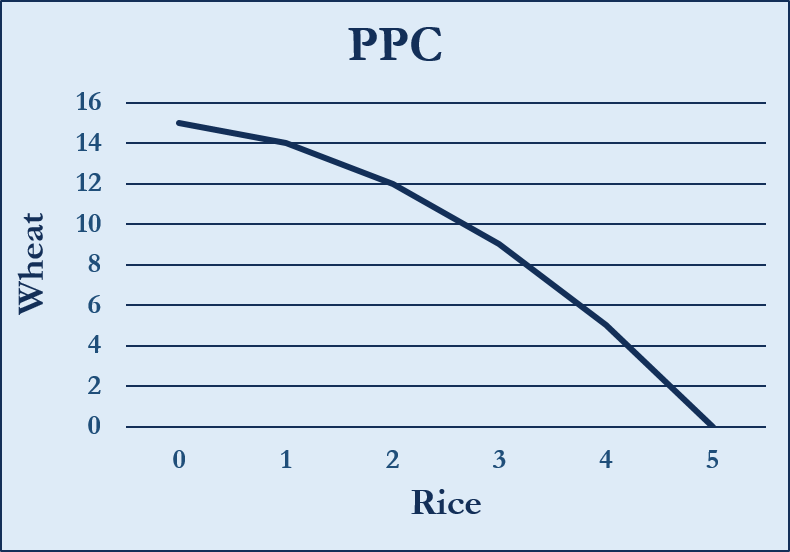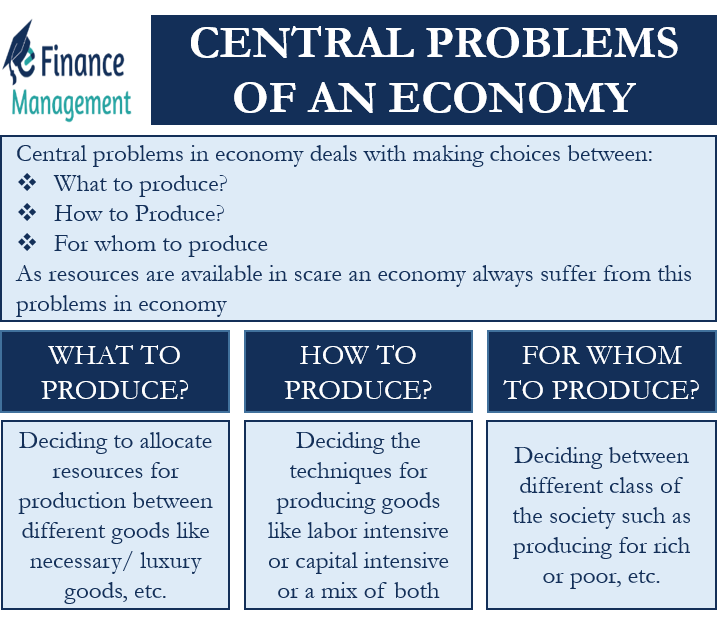What are the Central Problems of an Economy?
People all around the world need a host of goods and services ranging from food, clothing, shelter, medical facilities, transportation, entertainment, etc., in their daily lives. However, the resources in an economy are limited. Due to this reason, we have to make a number of choices daily. In order to consume product A, we have to give up product B. Similarly, we have to make a choice of producing one or a few products out of thousands of options available. This gives rise to three central problems of an economy that relate to the production, consumption, and distribution of goods and services: What to produce, How to produce, and for whom to produce.
These problems are omnipresent in every economy of the world. Let us look at these problems in detail.
What to produce?
Every society faces a major challenge of deciding “what to produce”? The production here includes not just tangible goods but services as well. Human beings have unlimited wants. Societies have to decide what is important to fulfill their basic needs as resources are limited, and we cannot produce everything. Moreover, there are alternative uses of any resource, and we need to make the best possible use of them.
The choices may include producing various types of food, clothing, items of daily use, etc. Market participants also have to allocate their resources effectively between necessities and luxury goods. They will produce luxury goods and services only after they allocate sufficient resources for the production of necessities.
The next important question associated with this problem in an economy is how much quantity of goods and services to produce. This will depend upon the availability of resources with individuals. Suppose land, labor, and raw materials are available in abundance with a person. He will first have to decide whether he will cultivate just one crop or multiple crops on his land. Then he will have to decide upon the quantity of each crop to cultivate depending upon the availability of resources with him.
Resources in society are limited not just at the individual level but at the level of the entire economy. In the quest for the most efficient allocation of available resources, we make the “Production Possibility Frontier.”
Production Possibility Frontier
A “Production Possibility Frontier” is a graphical representation of the various combinations of goods and services that we can possibly produce from the resources available to us and at a given level of technical expertise. Let us understand this with the help of an example.
Suppose an economy can produce just two products- (A) Wheat and (B) Rice. It uses all of its available resources and can produce the following combination of wheat and rice at the present level of technical expertise:
| Possible combinations | Wheat | Rice |
| A | 15 | 0 |
| B | 14 | 1 |
| C | 12 | 2 |
| D | 9 | 3 |
| E | 5 | 4 |
| F | 0 | 5 |
The first possible combination is using all the available resources for producing 15 units of wheat and no rice. Similarly, we have other combinations, with combination F being 5 units of rice and no unit of wheat. Now we will create a curve that represents all the production possibilities.

This graph represents the Production Possibility Frontier. The X-axis depicts the units of rice, and the Y-axis depicts the units of wheat that we can produce. Any combination or point that lies below the curve means that our resources are underutilized or getting wasted.
Also Read: Ten Principles of Economics
An economy has to choose between thousands of available combinations of goods and services which can be produced with the available resources and technology.

How to Produce?
The second central problem of an economy is “how to produce?” Individuals have to decide how they will produce the goods or services they have chosen. They need to efficiently allocate the available resources with them so as to maximize their utility. Producers have to choose between going labor-intensive, capital-intensive, or a mix of both. They also need to decide upon the technology to implement.
Producers need to consider two important aspects while deciding “how to produce.” They have to choose the best combination of the available factors of production that can maximize their output. Secondly, they also need to bring the cost down. They have to arrive at an optimal combination of new technology that can maximize the output and the least possible cost of production.
For Whom to Produce?
This is the third central problem of an economy. Once the goods and services are produced, the major question is how the production’s value will be distributed among different people. Societies need to be fair in their allocation of compensation for various services rendered during production. They will have to decide who will get more and who will get lesser, and by how much.
Producers have to decide about their target audience for whom they want to produce a good or provide a service. The resources are scarce or limited, and there is a difference in the paying capacity of people in an economy. For example, a rich person will be able to pay for an expensive wristwatch. Hence, a maker of expensive wristwatches will have to plan for his production, keeping in mind the rich people. He will have to trim his production as the demand for such watches will be limited. Moreover, he will have to target those markets that have a higher affluent customer base.
On the other hand, the maker of a mass-market product such as common bread will know that his target audience will be large. He will have to plan his production accordingly. He will have to go for high-capacity machines to meet the high demand. Also, he need not advertise much as in the case of high-end or luxury goods.
This problem also makes us think of the basic social problems in an economy. We have to decide whether a minimum amount of consumption should be ensured for every person in an economy or not. Also, other questions arise, such as should elementary education and basic healthcare facilities be free for all and how we can achieve this.
Summary: Central Problems of an Economy
The central problems of an economy revolve around the production and consumption of various goods and services. Each and every economy of the world faces these problems. Hence, it is essential for one and all to properly assess the available resources in hand so that they can be optimally utilized. Societies also need to focus on the growth of these resources since they are limited and may get exhausted. Moreover, we also have to look for the most technically efficient methods and styles of production at the minimum possible cost.
RELATED POSTS
- Production Possibility Frontier: Meaning, Assumptions, Graphical Curve, Interpretation, and More
- Centrally Planned Economy – Meaning, Features, Advantages, and Disadvantages
- Principle 1: People face Trade-offs
- ABC Analysis – Meaning, Categorization, Advantages, Disadvantages and Treatment
- Circular-Flow Diagram Model
- Socialist Economy – Meaning, Types, Advantages, and Limitations

